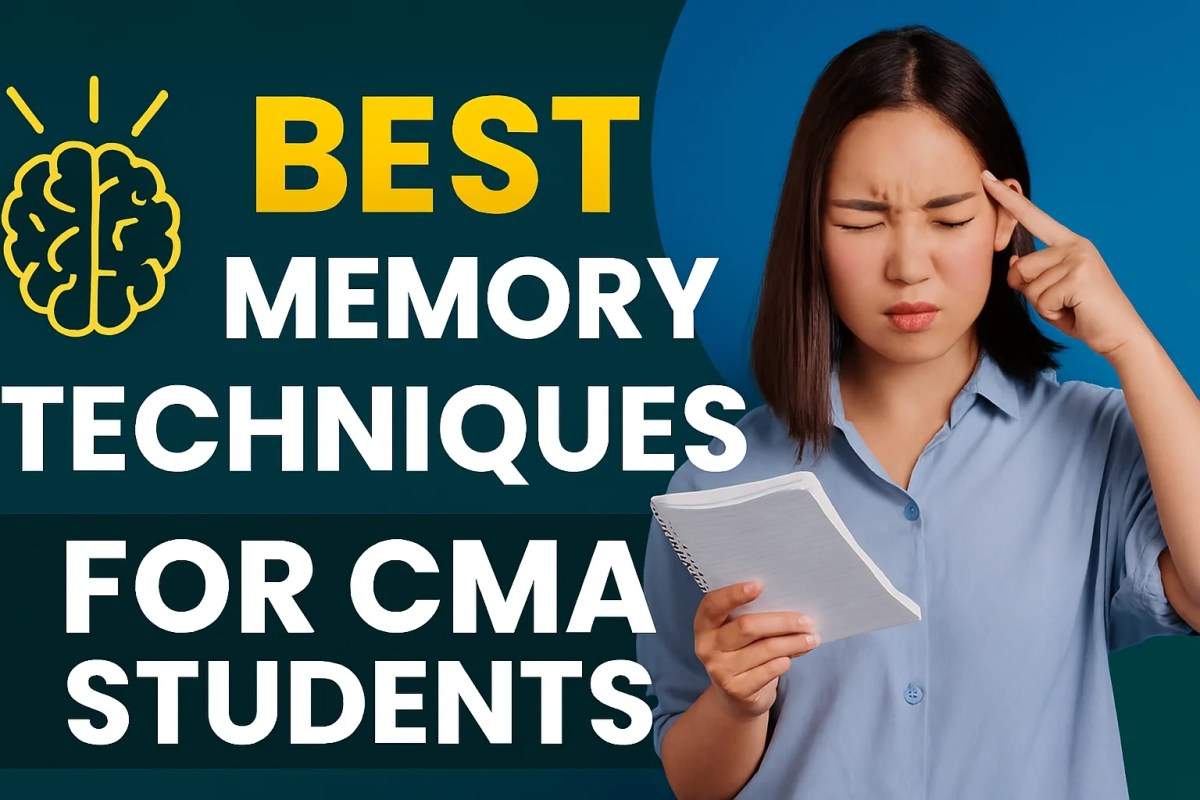This post has already been read 3 times!

Best Memory Techniques for CMA Students: Smart Study Hacks for Long-Term Retention
Techniques At A Glance
| Technique | What It Does | Practical Example (CMA-specific) |
|---|---|---|
| Focus & Meditation | Builds core concentration and removes mental clutter. | 5 min breathing before studying IndAS 115 enables sharper reading, fewer distractions, and better recall in MCQ. |
| Chunking | Breaks chapters into meaningful sub-parts so nothing gets left out. | Divide “GST Input Tax Credit” into eligibility, blocked credits list, ITC reversal, and matching process—study each as a mini-topic. |
| Visualization | Turns theory into pictures your brain can ‘see’ for easy recall. | Imagine the audit trail when learning vouching; visualize plant assets to remember depreciation rules. |
| Memory Palace | Links content to parts of your room for quick location-based retrieval. | Associate each room corner or table with Cost Accounting Standards for instant recall during revision. |
| Association | Connects tricky facts to relatable personal events or interests. | Remember Section 44ADA by pairing it with “Amit’s birthday in April” if your friend’s name is Amit and exam is in April. |
| Revision Cycle | “Forgets to Forget”—ensures you recall what you read last week by timely reviews. | Review each week’s Direct Tax notes on Sunday; set Google Calendar revision reminders. |
| Physical/Acupressure | Refreshes brain through short movements to bust mental fatigue. | Quick finger tapping (20 sec) or wrist stretches between MCQ solving sprints. |
| Passive Learning | Keeps information around you so your mind picks it up unconsciously. | Pasting depreciation rate tables near your bed or study table for daily subconscious revision. |
Practical Memory Hacks—Step-By-Step with Real CMA Scenarios
1. Focus & Remove Distraction (Meditation)
- Use apps like Headspace or Calm or just a timer when meditating.
- Try ‘Box Breathing’: Breathe in 4 seconds, hold 4, exhale 4, hold 4. Repeat x4 times.
- Write the session goal on sticky notes. Ex: “Today focus: Marginal Costing problems (no WhatsApp!)”.
2. Create a Dedicated Study Environment
- Desk should have only required books, not all your books (avoid overwhelm).
- Change study location if you get bored—revise theory on your balcony or in a library.
- Keep sticky notes for mistakes you commonly repeat and glance before exams.
3. Chunking & Microlearning
- For large lists: Write out only 5-7 items at a time on a flashcard. Master, then progress.
- Use mind maps to visualize chapters, e.g., IndAS hierarchy or GST workflows.
- Review by “chunks”: Revise GST returns separately from e-invoicing rules.
4. Immediate Revision Technique
- Set up a calendar (even on paper) for 1/2/5-day revision reminders.
- Record voice summaries and listen while walking or commuting.
- Pair up with a friend—teach one mini-topic to someone every week.
| Day | Action | Result |
|---|---|---|
| Day 1 | Study + 30-min summary note | Brain actively encodes |
| Day 2 | 7-min oral recap | Reinforces main points |
| Day 3 | 3–5 min flashcard session | Retrieval practice |
| Day 5 | Short test/self-quiz | Long-term implant |
5. Visualization (Imagine)
- Sketch quick diagrams or cartoons in your margin—even silly doodles stick in memory!
- Relate tricky accounting standards to your daily life (e.g., “lease accounting” = renting a scooter).
6. Association & Relate
- Use rhymes or “filmy” hooks for lists (e.g., “CGST, SGST, IGST all come to my GST fest!”).
- Pair audit procedures with events like wedding rituals to create story chains (e.g., vouching = invitation card checking).
7. Passive Learning: Posters, Songs, and Repetition
- Keep formula or sections posters in high-traffic zones at home.
- Recite summaries while doing daily chores—kitchen, brushing teeth, etc.
- Use recorded formula songs or mnemonics as audio reminders.
8. Environment & Memory Palace Tricks
- Use colored books or folders for different papers—visual association forms memory cues.
- Switch study location when stuck to trigger “place-prime” recall patterns.
9. Physical Exercise/Acupressure Hacks
- Press the tips of each finger using thumb – tip-to-tip, 10 secs per finger before reciting formulas.
- Try neck or shoulder rotations between mock test papers.
10. Morning Power & Healthy Routine
- Go for a 10-minute walk or fresh air break before your first morning session.
- Have a fixed bedtime—brain cements memory during sleep!
Frequently Asked Memory Questions for CMA
How can I recall multiple GST and Income Tax sections?
Use colored charts, rhymes, and visualize charts linked with poster locations.
Is studying with music good?
Yes, provided lyrics do not distract; opt for instrumental, low-volume tracks.
Can study partners help?
Absolutely! Ask your friend or sibling to quiz you randomly on important lists or concepts.
How do I revise everything efficiently?
Use the 1/2/5 technique, schedule weekly all-topic mini reviews, and mark your progress visibly on a calendar or progress tracker.
Should these techniques be used for practical subjects too?
Yes! Apply chunking, immediate revision, and focus breaks even for calculations and case study papers.
